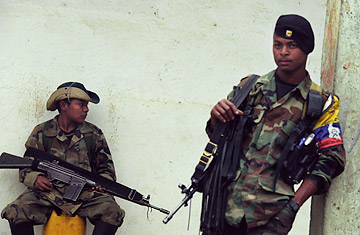
Rebel soldiers from the Revolutionary Armed Forces of Colombia, or FARC, in Tacueyo, Colombia
On Feb. 13, 2003, a plane carrying three U.S. military contractors crash-landed in rebel territory in southern Colombia. The survivors — Marc Gonsalves, Keith Stansell and Thomas Howes — were taken hostage by fierce Marxist guerrillas the Colombian Revolutionary Armed Forces, better known by the Spanish acronym FARC. It would take five years, and the help of billions of dollars in U.S. aid, before commandos of the Colombian Army were able to launch a daring, Mission: Impossible-style sting operation in a bid to save the hostages. Colombian planners of the July 2008 operation were probably keen to avoid the fate of the earliest rescue attempt. The misadventures of that fiasco, along with the final rescue attempt, are detailed in a new book by veteran Latin America journalist John Otis, Law of the Jungle: The Hunt for Colombian Guerrillas, American Hostages and Buried Treasure. An excerpt follows:
Was it the water? Or the wild monkey? Either way, the improvised Amazon chow was playing havoc with Walter Suárez's innards. Suárez was part of a contingent of 147 Colombian soldiers punching through the snarled jungle foliage as part of a massive operation to encircle the guerrillas holding Keith Stansell, Marc Gonsalves, and Tom Howes. But as the troops marched deeper into the wild, they began running out of supplies.
To feed themselves, the soldiers aimed for macaws with their slingshots. They killed borugos, a kind of Amazon rodent that looks like a cross between a squirrel and a rat and is a popular source of jungle protein. They also bagged monkeys, which they would stew for hours before braising over a fire in an attempt to cook away the gamey taste. But the meat was stringy and tough and as they gnawed on the primates' tiny arms and legs, some of the soldiers felt like they were eating their young. Others couldn't keep anything down. Now, drifting in the netherworld between sleep and consciousness, Suárez twisted and turned in his hammock until he finally popped awake in the early- morning light. His stomach was about to detonate.
Suárez made his way past his colleagues in search of some privacy. Adding to the indignity of the moment, he'd run out of toilet paper, so he tore off the sleeves of a tattered T-shirt in his backpack. He squatted behind a tree and, to help balance himself, used both hands to drive his machete into the ground.
But something didn't feel right. As the blade pierced the soil, the metal struck something hard that gave off a hollow thud. Intrigued, Suárez finished his business, hitched up his pants, and began rooting around with his hands. After burrowing down about one foot, he discovered the top of a blue plastic five- gallon container. Suárez pried off the lid. Like foam in a beer stein, a white substance topped the 30-inch-tall barrel. Was it cocaine? Suárez plunged his hands into the powder, which turned out to be ant poison, then pulled out block after block of blue-and-white 20,000-peso bills.
Suárez's heart raced. Each plastic- wrapped packet contained a thousand banknotes, or 20 million Colombian pesos — the equivalent of nearly $7,000. His wallet had never held more than petty cash, but now he was stuffing his uniform pockets with thick wads of currency. It wasn't easy because his whole body quaked with the snap realization that he, Walter Suárez, a $44-a-week anonymous soldier condemned to a mission impossible, had just won a kind of ad hoc lottery.
